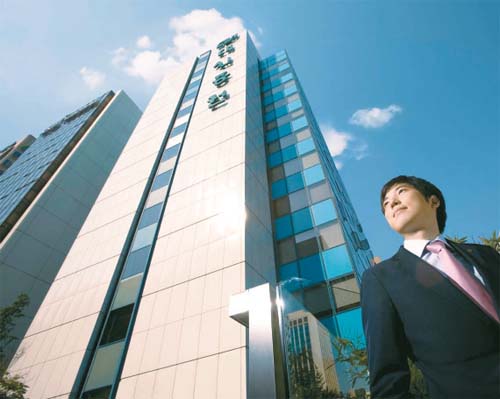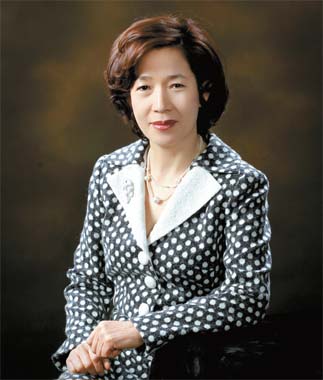Steady hand has helped Daishin

Daishin Group’s headquarters in Yeouido, Seoul. Provided by the company.
In the Korean securities market, it is quite difficult for an independent securities company to build its foundation and compete against bigger rivals, including jaebeol and securities firms that operate with banks.
However in its 47 years, Daishin Securities, the flagship company of the Daishin Group, managed to withstand the turbulent Korean economy during the late 1970s, the aftermath of the Asian financial crisis and the recent global economic crisis.
Last year, the company’s annual sales totaled 2.82 trillion won ($2.34 billion), with operating profit of 100.1 billion won. Daishin Group sales in 2008 hit 2.83 trillion won.

Lee Uh-ryung (57)
Daishin Securities started operating under its present name in 1975 when the founder and current honorary chairman, Yang Jae-bong, purchased Samrak Securities.
Yang managed to make many firsts for Daishin.
In its founding year, Daishin Securities was Korea’s first securities company to introduce a “public hiring” system in which new employees were hired through the company’s own, official process, every year. Daishin’s management system differs from other securities companies which have frequent employee hiring and firing.
The company still sees many of its employees retire because of age, rather than other reasons.
In October 1975, Daishin Securities was the first local securities firm to list shares on the Korea Stock Exchange. In 2004, the company introduced the first online transaction system for companies to buy and sell stocks and bonds. It exported this system to Taiwan and Thailand.
When the Asian financial crisis hit, other large-scale securities firms, including Dongsuh Securities, closed. But Daishin was able to survive by selling off 500 billion won worth of shares ahead of time, converting the money into short-term loans.
Daishin’s name, “dai” meaning big and “shin” meaning trust, is quite fitting for its rather conservative but steadfast nature. The company has always excelled in risk management, allowing it to continue to steadily climb up in status, instead of growing at light speed. During the late 1990s, many local securities firms made their money by selling high interest beneficiary certificates, including Daewoo subsidiaries’ bonds. Daishin, however, stuck with selling treasury bonds.
Amidst the Asian financial crisis in 1997 and 1998, the Daewoo Group, one of Korea’s biggest conglomerates at the time, issued a large amount of high-yield bonds to avoid insolvency. However, when the Daewoo Group went bankrupt, Daishin’s competitors could not redeem the beneficiary certificates presented by the investors who wanted to cash in after Daewoo Group’s downfall. This decision by Daishin to sell treasury bonds only, made it possible for the company to avoid huge losses.
During the recent global economic crisis, Daishin’s risk management paid off as well. In 2007, when the local securities market was strong, many companies started increasing their investments and opening new branches quite aggressively. Daishin however, did the opposite, lowering the volume of its high risk businesses. It cut down on its investments and bought back some of its old investments to secure more liquidity.
On the sturdy success of Daishin Securities, especially during the 1980s when Korea’s stock market was doing well, the company was able to transform itself into a group.
It was during this time that its other two subsidiaries were launched. In 1984, Daishin Economic Research Institute was founded, and, in 1988, Daishin Investment Trust Management opened.
Yang retired from his post as chairman in 2001, to hand over the company to his second son, the late Yang Hye-moon, who started his career with Daishin in 1975. During his brief post as chairman of Daishin Group, he was known to emphasize “clean management” and stressed corporate transparency which resulted in Daishin being picked in various media polls as one of the most favored local companies that foreign companies want to invest in.
Since 2004, Yang Hye-moon’s widow, Lee Uh-ryung, has been the chairwoman of the Daishin Group.
After Lee took over as head, the group has been branching out globally, launching Daishin Securities branches in Asia, including branches in Hong Kong, China and Tokyo. The group plans to make its Hong Kong branch its center for the Asian market and concentrate on investment banking.
From this year, the overseas branches have been seeing a turnaround, through aggressively diversifying its business portfolio to include not only its core retail-related services, but others, including asset management, investment banking, treasury management and personal loans. This October, Daishin plans to launch its “financial doctor service” for retail customers.
Roh Chung-nam, president and chief executive officer of Daishin Securities, started his career in finance in 1977, when he was hired at Hanil Bank. In 1987, he went to work for Daishin Securities global business division.
From that time until the present, Roh, known as the “global business hand” in Daishin, has stressed customer rights above all else. He has said in past media interviews that the single most important thing that Daishin Securities has to do is to “safely grow customers’ precious money.”
He added that the “financial doctor service” is a part of Daishin’s efforts to become more customer-friendly. In this effort, top company employees provide a “total consultation service” from top to bottom.
Shim Choong-bo, president of Daishin Economic Research Institute, first started in the institute back in 1985. He is noted as an “economics scholar” of the group and formerly headed the institute’s investment strategy division for three years beginning in 1996.
Lee Hyeong-cherl, president of Daishin Investment Trust Management since 2008, started as the branch manager of Daishin Securities branch in Daichi-dong, Southern Seoul in 1999.
He was head of the company’s stock division and customer management department before being appointed to his present post.
*“Faces inside Korea’s conglomerates,” a regular weekly series about key figures in the nation’s major companies, will also feature major figures within Korea’s large financial groups.
By Cho Jae-eun [jainnie@joongang.co.kr]










with the Korea JoongAng Daily
To write comments, please log in to one of the accounts.
Standards Board Policy (0/250자)